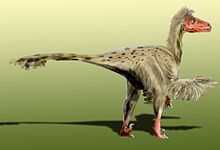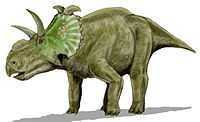Oldman Formation
| Oldman Formation Stratigraphic range: Upper Cretaceous, 77.5–76.5Ma | |
|---|---|
| Type | Geological formation |
| Unit of | Belly River Group |
| Underlies | Dinosaur Park Formation |
| Overlies | Foremost Formation |
| Thickness | up to 328 feet (100 m)[1] |
| Lithology | |
| Primary | Sandstone |
| Other | Mudstone and bentonite |
| Location | |
| Coordinates | 49°37′41″N 112°53′23″W / 49.62806°N 112.88972°WCoordinates: 49°37′41″N 112°53′23″W / 49.62806°N 112.88972°W |
| Region | Western Canada Sedimentary Basin |
| Country |
|
| Type section | |
| Named for | Oldman River |
| Named by | Russell, L.S. and Landes, R.W., 1940.[2] |
The Oldman Formation is a stratigraphic unit of Late Cretaceous (Campanian stage) age that underlies much of southern Alberta, Canada. It consists primarily of sandstones that were deposited in fluvial channel and floodplain environments. It was named for exposures along the Oldman River between its confluence with the St. Mary River and the city of Lethbridge, and it is known primarily for its dinosaur remains and other fossils.[3]
Lithology
The Oldman Formation is composed primarily of light-colored, fine-grained sandstones. They are upward-fining, lenticular to sheet-like bodies that are yellowish, steep-faced and blocky in outcrop. The formation also includes lesser amounts of siltstone and mudstone.[4]
Depositional Environments
The sediments of the Oldman Formation were deposited in fluvial channels (the sandstones) and a variety of channel margin, overbank and floodplain environments (the siltstones and mudstones). The formation is about 40 metres (130 ft) thick at Dinosaur Park in southeastern Alberta. It thickens toward the southwest, and northwestern Montana appears to have been the primary source of the sediments.[4]
Relationship to other units
The Oldman Formation is a member of the Belly River Group (also known as the Judith River Group). It conformably overlies the Foremost Formation, and is separated from the overlying Dinosaur Park Formation by a regional disconformity. The sediments of the Oldman are superficially similar to those of the Dinosaur Park, which was included in the Oldman Formation prior to the recognition of the disconformity. The two formations can also be distinguished by petrographic and sedimentologic differences.[3][4]
Age
The Oldman Formation was deposited during the middle Campanian, between about 77.5 and 76.5 million years ago.[5] It lies fully within magnetic polarity Chron 33n.[6]
Fauna
List of dinosaurs found in the formation:[5][7]
Theropods
| Theropods reported from the Oldman Formation | ||||||
|---|---|---|---|---|---|---|
| Genus | Species | Location | Stratigraphic position | Material | Notes | Images |
|
D. torosus |
Upper through lower |
Several specimens |
A tyrannosaurid |
| ||
|
Indeterminate |
Teeth |
A dromaeosaurid | ||||
|
Dromiceiomimus |
D. brevitertius |
Misreported | ||||
|
E. elegans |
Misreported, found in the Dinosaur Park, Hell Creek, and Two Medicine Formations | |||||
|
H. elizabethae |
Foot claw |
A dromaeosaurid | ||||
|
Indeterminate |
Teeth |
A troodontid | ||||
|
Ricardoestesia |
R. isosceles |
Misreported | ||||
|
Indeterminate |
Teeth |
A dromaeosaurid | ||||
|
S. langstoni |
Partial remains |
A dromaeosaurid | ||||
|
T. formosus |
Teeth, eggs, embryos |
A troodontid, also found in the Dinosaur Park, Judith River, Lance, and Two Medicine Formations | ||||
Ornithischians
| Ornithischians reported from the Oldman Formation | ||||||
|---|---|---|---|---|---|---|
| Genus | Species | Location | Stratigraphic position | Material | Notes | Images |
|
A. nesmoi |
Lower |
A ceratopsid |
| |||
|
Indeterminate |
A ceratopsid | |||||
|
B. canadensis |
Upper |
|||||
|
C. brinkmani |
Upper |
A ceratopsid | ||||
|
C. brevirostris |
Junior synonym of C. russelli. | |||||
|
C. russelli |
Upper |
A ceratopsid, also found in the Dinosaur Park Formation | ||||
|
C. casuarius |
Upper |
A hadrosaurid, also found in the Dinosaur Park Formation | ||||
|
E. tutus |
An ankylosaurid, actually from the Dinosaur Park Formation.[8] | |||||
|
G. incurvimanus |
Junior synonym of G. notabilis | |||||
|
G. notabilis |
Upper |
A hadrosaurid, also found in the Dinosaur Park Formation | ||||
|
H. stebingeri |
A hadrosaurid, actually from the Dinosaur Park Formation | |||||
|
L. lambei |
A hadrosaurid, actually from the Dinosaur Park Formation | |||||
|
P. walkerii |
Upper |
A hadrosaurid, also found in the Dinosaur Park Formation | ||||
|
S. cutleri |
Upper |
An ankylosaurid, may actually be from the Dinosaur Park Formation | ||||
See also
- List of fossil sites (with link directory)
- List of dinosaur-bearing rock formations
Footnotes
- ↑ Lexicon of Canadian Geological Units. "Oldman Formation". Retrieved 2009-02-06.
- ↑ Russell, L.S. and Landes, R.W., 1940. Geology of the southern Alberta Plains; Geological Survey of Canada, Memoir 221.
- ↑ 3.0 3.1 Eberth, D.A. and Hamblin A.P. 1993. Tectonic, stratigraphic, and sedimentologic significance of a regional discontinuity in the upper Judith River Group (Belly River wedge) of southern Alberta, Saskatchewan, and northern Montana. Canadian Journal of Earth Sciences 30: 174-200.
- ↑ 4.0 4.1 4.2 Eberth, D.A. 2005. The geology. In: Currie, P.J., and Koppelhus, E.B. (eds), Dinosaur Provincial Park: A Spectacular Ancient Ecosystem Revealed. Indiana University Press: Bloomington and Indianapolis, p. 54-82. ISBN 0-253-34595-2.
- ↑ 5.0 5.1 Arbour, V. M.; Burns, M. E.; and Sissons, R. L. (2009). "A redescription of the ankylosaurid dinosaur Dyoplosaurus acutosquameus Parks, 1924 (Ornithischia: Ankylosauria) and a revision of the genus". Journal of Vertebrate Paleontology 29 (4): 1117–1135. doi:10.1671/039.029.0405.
- ↑ Lerbekmo, J.F. 1989. The position of the 33-33r (Campanian) polarity chron boundary in southeastern Alberta. Bulletin of Canadian Petroleum Geology 37: 43-47.
- ↑ Weishampel, D.B., Barrett, P.M., Coria, R.A., Le Loueff, J., Xu X., Zhao X., Sahni, A., Gomani, E.M.P., & Noto, C.N. 2004. Dinosaur distribution. In: Weishampel, D.B., Dodson, P., & Osmólska, H. (Eds.). The Dinosauria (2nd Edition). Berkeley: University of California Press. Pp. 517-606.
- ↑ Penkalski, P. (2013). "A new ankylosaurid from the late Cretaceous Two Medicine Formation of Montana, USA". Acta Palaeontologica Polonica. doi:10.4202/app.2012.0125.
References
- D.A. Eberth. 1996. Origin and significance of mud-filled incised valleys (Upper Cretaceous) in southern Alberta, Canada. Sedimentology 43:459–477
- Ryan, M. J., and Russell, A. P., 2001. Dinosaurs of Alberta (exclusive of Aves): In: Mesozoic Vertebrate Life, edited by Tanke, D. H., and Carpenter, K., Indiana University Press, pp. 279–297.
| |||||||||||






